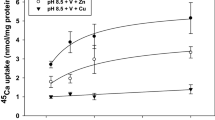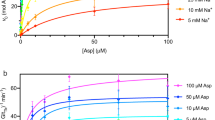Abstract
Cl− absorption by theAplysia californica foregut is effected through an active Cl− transport mechanism located in the basolateral membrane of the epithelial absorptive cells. These basolateral membranes contain both Cl−-stimulated ATPase and ATP-dependent Cl− transport activities which can be incorporated into liposomes via reconstitution. Utilizing the proteoliposomal preparation, it was demonstrated that ATP, and its subsequent hydrolysis, Mg2+, Cl−, and a pH optimum of 7.8 were required to generate maximal intraliposomal Cl− accumulation, electrical negativity, and ATPase activity. Additionally, an inwardly-directed valinomycininduced K+ diffusion potential, making the liposome interior electrically positive, enhanced both ATP-driven Cl− accumulation and electrical potential while an outwardly-directed valinomycininduced K+ diffusion potential, making the liposome interior electrically negative, decreased both ATP-driven Cl− accumulation and electrical potential compared with proteoliposomes lacking the ionophore. Either orthovanadate orp-chloromercurobenzene sulfonate inhibited both the ATP-dependent intraliposomal Cl− accumulation, intraliposomal negative potential difference, and also Cl−-stimulated ATPase activity. Both aspects of Cl− pump transport kinetics and its associated catalytic component kinetics were the first obtained utilizing a reconstituted transporter protein. These results strongly support the hypothesis that Cl−-ATPase actively transports Cl− by an electrogenic process.
Similar content being viewed by others
References
Blanck, A., and Oeslerhelt, D. (1987).EMBO J. 6, 265–273.
Gerencser, G. A. (1981).Am. J. Physiol. 240, R61-R69.
Gerencser, G. A. (1983).Am. J. Physiol. 244, R143-R149.
Gerencser, G. A. (1984).Biochim. Biophys. Acta 775, 389–394.
Gerencser, G. A. (1988).Am. J. Physiol. 254, R127-R133.
Gerencser, G. A. (1990).Biochim. Biophys. Acta 1030, 301–303.
Gerencser, G. A. (1993a).FEBS Lett. 333, 137–140.
Gerencser, G. A. (1993b).Biochem. Biophys. Res. Commun. 196, 1188–1194.
Gerencser, G. A., and Lee, S. H. (1985a).Am. J. Physiol. 248, R241-R248.
Gerencser, G. A., and Lee, S. H. (1985b).Biochim. Biophys. Acta 816, 415–417.
Gerencser, G. A., and White, J. F. (1980).Am. J. Physiol. 239, R445-R449.
Gerencser, G. A., and Zelezna, B. (1992).Zool. Sci. 9, 925–939.
Gerencser, G. A., and Zelezna, B. (1993).Proc Natl. Acad. Sci. 90, 7970–7974.
Gerencser, G. A., White, J. F., Gradmann, D., and Bonting, S. L. (1988).Am. J. Physiol. 255, R677-R692.
Ikeda, M., Schmid, R., and Oesterhelt, D. (1990).Biochemistry 29, 2057–2065.
Inagaki, C., and Shiroya, T. (1988).Biochem. Biophys. Res. Commun. 154, 108–112.
Lukacovic, M. F., Feinstein, M. B., Shalafi, R. I., and Perrine, S. (1981).Biochemistry 20, 3145–3151.
McCormick, J. I., Silivius, J. R., and Johnstone, R. M. (1985).J. Biol. Chem. 260, 5706–5714.
Nyren, P., and Baltscheffsky, M. (1983).FEBS Lett. 155, 125–130.
Pedersen, P. L., and Carafoli, E. (1987).Trends Biochem. Sci. 12, 146–150.
Post, R. L., Sen, A. K., and Rosenthal, A. S. (1965).J. Biol. Chem. 240, 1437–1445.
Rothstein, A. (1970).Current Topics in Membranes and Transport (Bronner, F., and Kleinzeller, A., eds.), Academic Press, New York, pp. 135–176.
Schuurmans-Stekhoven, F., and Bonting, S. L. (1981).Physiol. Rev. 61, 1–76.
Shiroya, T., Fukunaga, R., Akashi, K., Shimada, N., Takagi, Y., Nishino, T., Hara, M., and Inagaki, C. (1989).J. Biol. Chem. 264, 17416–17421.
Slayman, C. L., and Zuckier, G. R. (1989). InBicarbonate, Chloride, and Proton Transport Systems (Durham, J., and Hardy, M., eds.),Ann. N.Y. Acad. Sci. 574, 233–245.
Vara, F., and Serrano, R. (1982).J. Biol. Chem. 257, 12826–12830.
Zeng, X-T., Hara, M., and Inagaki, C. (1994).Brain Res. 641, 167–170.
Zimniak, P., and Racker, E. (1978).J. Biol. Chem. 253, 4631–4637.
Author information
Authors and Affiliations
Rights and permissions
About this article
Cite this article
Gerencser, G.A., Purushotham, K.R. Reconstituted Cl− pump protein: A novel ion(Cl−)-motive ATPase. J Bioenerg Biomembr 28, 459–469 (1996). https://doi.org/10.1007/BF02110436
Received:
Accepted:
Issue Date:
DOI: https://doi.org/10.1007/BF02110436




